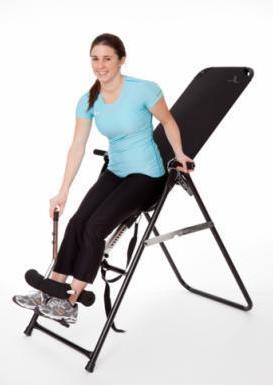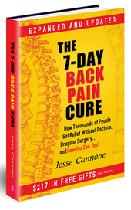|
What is an Inversion Table
and How Would I Use One?
Exactly what is an inversion table? Why would I want to lie head down like that anyway?
Your backbone holds up your upper body and anything you are carrying on your back or with your arms. Your back holds a load up while gravity pulls it down. As you age or if you are working it too hard or incorrectly or not drinking enough water you gradually lose this battle and you have various degrees of spinal compression. Gravity never stops or turns off; it doesn't get tired. However, there is a simple way you can use gravity to help counteract its own effect on your spine.
With all the back problems in our society you would think that modern medicine would be on to this but it has been virtually ignored (perhaps because it can't be exclusively patented). Most people if they heard of it would ask "what is an inversion table?" - they have no idea that such a device could help their aching backs.
Inversion therapy is a method of treating back pain by diminishing the influence of gravity, reducing the compression of the vertebrae and discs and allowing the muscles and ligaments that encase the spine to relax.
This is typically performed on what's called an inversion table. The table allows you to lie on your back relaxed and rotate back into a partially- or fully-inverted position. This position eliminates some or all gravitational compression, depending upon how far back you position your body.
Inversion therapy is the safest, quickest and most effective way to increase the space between your vertebrae. Numerous clinical studies published in reputable medical journals have confirmed that inversion really does increase the separation between the discs of the spine, which often brings relief from back pain.
For instance, one study considered 175 people who were unable to work due to back pain. After eight inversion treatments, 155 of the patients were able to return to work full time.
How long would I need be inverted and how often would I have to do this?
As a general guideline, inverting for 1-3 minutes, 1-3 times per day for the first week or 2 is a good start. You can then gradually adjust the amount of time and the degree of inversion as you become more comfortable looking at the world from a different angle.
Also, the degree of inversion also affects how long you need to invert. So the shallower the degree, the longer you would invert to get the same benefit. With a higher degree of inversion (towards completely upside-down), the shorter the inversion time. However it will vary considerable upon you and how you feel and what you want to get from it.
How long will it take to see results?
This is completely dependent on the condition of your spine and any injuries causing you pain. For example, if you're dealing with tight muscles in your upper back/neck caused by stress, you'll typically see very rapid (or even immediate) improvements. More serious situations, however, may take weeks or even months to improve. Of course, it will also depend on what other treatments you're taking, your general mindset and diet, the condition of your circulatory system etc.
Do I have to be completely upside-down?
No, there is benefit to be had from even a shallow inversion. You can invert anywhere from about 20-30 degrees from horizontal all the way to a full inversion at 90 degrees - completely upside down.
Any discomfort you may feel on the inversion table is usually from trying to invert too much, too fast. The recommendation is that beginners start at around 20-30 degrees for the first week or 2, simply to get used to being in an inverted position. You will still get a good effect even at this low and much more comfortable degree. Then you can increase the angle of inversion up towards 60 degrees if you feel ready for it. Many people never have to go beyond this angle, and still get considerable benefit from inversion. If you do go to full inversion, start out with only about 30 seconds or to allow your body to get used to it.
"Intermittent traction"
This is done by inverting at 90 degrees for 20-30 seconds, then return upright for another 20-30 seconds and oscillate back and forth between the two positions. Many doctors using inversion therapy prefer this method because it stimulates circulation on a higher level, which speeds waste removal from the injured discs or other areas.
So if you have wondered: "what is an inversion table," now you know and have some idea of what it can do. The next page will describe the
benefits of inversion table therapy.
What is an inversion table? - Product pages:
Sales page for HBI Premium Inversion Table
|
Keep up to date with
valuable insights into
pain management via
a healthy lifestyle.
Receive the monthly
Natural Pain Relief
Guide Newsletter.
News articles, health
tips, specials, freebies.
Enter your email and name
in the form to the right.
|
|
|








New! Comments
Have your say about what you just read! Leave me a comment in the box below.